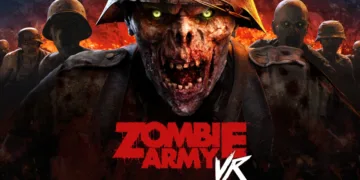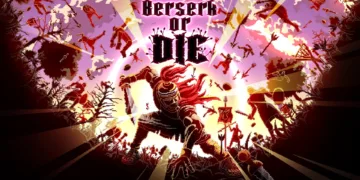Zombie Army VR marks Rebellion’s first serious venture into virtual reality, adapting their cult zombie-shooting franchise for headset-wearing audiences. This VR iteration, co-developed with Xtended Realities, takes the established formula from the Zombie Army series—itself a supernatural spin-off of the tactical Sniper Elite games—and transplants it into an immersive first-person experience across all major VR platforms including PSVR2, Meta Quest 3, and PC VR headsets.
The premise remains deliciously absurd: in an alternate post-WWII timeline, Zombie Hitler’s death has unleashed hordes of undead Nazi soldiers across Europe. Players step into the boots of a Deadhunter, an elite zombie-killing operative working under the command of Hermann Wolff to clean up the supernatural mess while searching for his missing family. The action unfolds primarily in the bombed-out ruins of Nuremberg and other war-torn European locations, creating an atmospheric backdrop for what amounts to an arcade-style shooting gallery.
Rather than attempting to revolutionize the VR shooter formula, Zombie Army VR doubles down on straightforward, score-focused gameplay. The experience centers on manual weapon reloading, combo multipliers, and the franchise’s signature X-ray kill cams, all wrapped in a package designed for players seeking uncomplicated zombie-blasting action. This approach positions the game as comfort food for VR enthusiasts—familiar, accessible, and designed to deliver exactly what the title promises.
Combat Mechanics and Arsenal Management
The core gameplay loop follows a predictable but functional structure built around linear level progression punctuated by arena-style encounters. Players advance through environments until reaching designated areas where exits become mysteriously blocked, forcing confrontation with waves of incoming zombies. This design choice, while common in the genre, feels somewhat artificial and limits tactical options compared to more organic enemy placement.
The weapon system employs a three-gun loadout: a sniper rifle serving as the primary weapon, a secondary automatic weapon like a Thompson submachine gun or shotgun, and a backup pistol. Each weapon category demands different handling techniques, with sniper rifles requiring two-handed aiming and stability management, while smaller weapons support dual-wielding for increased firepower. The manual reloading system becomes central to the experience, requiring players to physically grab ammunition from their belt or pouch, eject spent magazines, and chamber new rounds under pressure.
Weapon customization adds depth through collectible upgrade kits scattered throughout levels. These modifications affect meaningful attributes like damage output, stability, firing rate, and magazine capacity, allowing players to tailor their arsenal to preferred playstyles. The progression system rewards stylish kills and combo maintenance, converting performance into experience points that unlock further weapon enhancements.
VR-specific mechanics extend beyond basic weapon handling to include physical grenade throwing—offering both manual tossing and simplified button activation—and melee combat with limited-durability weapons like hammers and wrenches. However, the scope aiming implementation proves problematic, as the sniper scope blacks out the entire view rather than providing a more natural aiming experience.
Enemy variety attempts to maintain engagement across the campaign’s duration. Standard shambling zombies provide basic cannon fodder, while armored variants wearing helmets and protective gear require more precise targeting. Ranged attackers armed with weapons, kamikaze explosive zombies, and heavy brutes add tactical considerations, though the AI remains fairly predictable. Boss encounters punctuate level conclusions, demanding sustained firepower and positioning awareness.
The scoring system draws from classic arcade sensibilities, rewarding consecutive kills with combo multipliers and converting performance into leaderboard rankings. This approach works well for players who appreciate score-chasing mechanics, though it may feel dated for those expecting more sophisticated progression systems.
Technical Foundation and VR Polish
Zombie Army VR demonstrates competent technical execution across its supported platforms, though performance varies notably between hardware configurations. The PSVR2 version achieves stable 90 FPS performance with minimal reprojection, making effective use of the platform’s haptic feedback and adaptive trigger resistance. The Meta Quest 3 delivers clean visuals despite some lighting limitations, while PC VR maintains sharp presentation with consistent framerates across compatible headsets.
The development team clearly built the experience for VR from the ground up rather than porting existing content, evidenced by thoughtful comfort options including seated and standing play modes, dominant hand selection, and proper VR weapon mechanics implementation. The 3D audio design proves particularly effective, providing crucial situational awareness cues that help players track enemy positions and incoming threats.
However, several technical limitations detract from the immersion factor. Objects held close to the player’s face exhibit noticeable stuttering, creating a jarring visual effect when examining weapons or items in detail. Aliasing issues become apparent on straight edges and metal surfaces, while environmental interaction remains disappointingly limited compared to other VR titles. The sniper scope implementation, which blacks out the entire view rather than providing a more natural magnified perspective, feels like a missed opportunity for proper VR adaptation.
The inventory management system, while functional, lacks the physics-based interaction found in more immersive VR experiences. Players access equipment through a flat UI overlay rather than physically interacting with backpacks or holsters, which reduces the tactile satisfaction that defines exceptional VR design. Despite these limitations, the weapon handling itself feels responsive and satisfying, with proper weight distribution and recoil simulation that enhances the combat experience.
Visual presentation maintains consistency with the franchise’s established aesthetic, featuring colorful presentations despite dark thematic content. Texture quality varies by platform, with PC VR offering the sharpest detail and Quest 3 showing more noticeable compression. Environmental storytelling through level design helps establish atmosphere, though the overall visual fidelity falls short of cutting-edge VR standards.
Solo Campaign vs Cooperative Play
The single-player campaign spans approximately five hours of linear progression, structured around checkpoint-based advancement through European battlefield locations. Solo play presents unique challenges that reveal both the game’s strengths and fundamental design limitations. Playing alone requires constant 360-degree awareness as enemies approach from multiple directions, creating genuine tension during intense encounters. However, this design choice often feels overwhelming rather than strategically engaging, particularly in later levels where enemy density increases significantly.
The cooperative implementation transforms the entire experience, supporting two-player online sessions that feel substantially more balanced and enjoyable. Level design clearly prioritizes two-player coordination, with enemies typically attacking from two main directions that naturally divide defensive responsibilities between teammates. The revival mechanic adds meaningful teamwork elements, while shared resource management and coordinated tactics create satisfying strategic depth.
Co-op advantages extend beyond basic combat management to include synchronized sniper shots, strategic positioning, and the inherent entertainment value of shared chaos. The experience becomes significantly more manageable when players can cover each other’s flanks and coordinate reloads, transforming potentially frustrating encounters into engaging tactical puzzles.
Unfortunately, technical limitations hamper the cooperative experience. The absence of crossplay support between platforms restricts partner options, while missing in-game voice chat on PSVR2 requires external communication solutions. Players also lose checkpoint progress when joining co-op sessions mid-campaign, creating unnecessary friction for those wanting to experience the story together.
The difficulty scaling clearly favors cooperative play, with solo players facing constant pressure from multiple threat vectors while co-op teams can establish defensive positions and coordinate responses. This design choice makes the cooperative mode feel like the intended experience, relegating single-player to a secondary consideration.
Content Structure and Long-term Appeal
The campaign structure follows a straightforward progression through varied European environments including underground bunkers, trench systems, and ruined villages. While the locations provide atmospheric diversity, some levels resort to reverse layouts of previous areas, suggesting content padding rather than genuine variety. Boss encounters at level conclusions provide climactic moments, though they rarely deviate from standard “shoot until dead” mechanics.
Collectible hunting adds modest replay incentive through hidden items scattered throughout levels. Players can discover weapon customization materials like paint cans and upgrade kits, alongside atmospheric collectibles such as creepy dolls that enhance the horror ambiance. Trophy and achievement integration provides additional completion goals, though these feel more obligatory than compelling.
The progression system offers weapon upgrade trees with meaningful improvements, allowing players to enhance damage output, stability, and capacity across their preferred weapons. Cosmetic customization options provide personalization without affecting gameplay balance, while experience points accumulated through stylish kills create a sense of advancement. Leaderboard competition adds competitive elements for score-focused players.
However, replay incentives prove limited beyond initial completion. Challenge objectives for each level and medal systems encourage perfect runs, but the lack of challenge modes, modifiers, or traditional survival modes feels like missed opportunities. The weapon unlock progression stops mid-campaign, reducing long-term engagement for players seeking continuous advancement.
The central hub area serves as a competent launching point for missions, featuring a weapon testing range for practice, upgrade workbench for customization, and character selection offering cosmetic differences only. While functional, these elements feel perfunctory rather than engaging, lacking the personality and depth found in more ambitious VR experiences.
Franchise Heritage and Distinctive Elements
The X-ray kill cam system represents Zombie Army VR’s most distinctive feature, adapting Sniper Elite’s signature slow-motion bullet tracking for three-dimensional space. When functioning properly, these sequences provide visceral satisfaction as bullets penetrate zombie anatomy in graphic detail. However, the VR implementation suffers from technical issues including bullet clipping through skulls without visible impact and inconsistent anatomical accuracy that diminishes the feature’s trademark impact.
The World War II atmosphere remains intact, featuring authentic period weapons and equipment within post-apocalyptic European battlefield environments. The occult and supernatural story elements blend seamlessly with the military setting, creating blood-drenched bunkers and atmospheric locations that capture the franchise’s pulpy horror aesthetic. Grotesque zombie designs incorporating Nazi imagery maintain the series’ controversial but distinctive visual identity.
Audio design deserves particular recognition for its weapon sound effects, which provide satisfying impact and weight to each shot. Explosion feedback through headset vibration enhances immersion, while environmental audio cues help players locate threats and navigate combat scenarios. Voice acting for mission briefings and character interactions maintains competent quality, though the thin narrative structure limits opportunities for memorable dialogue.
The visual style successfully translates the franchise’s dark, gritty aesthetic into VR, maintaining colorful presentation despite thematically dark content. Environmental storytelling through level design helps establish atmosphere and context, though texture quality varies significantly between platforms. The gore and visceral combat effects remain central to the experience, delivering the franchise’s trademark blend of historical setting and supernatural horror.
Assessment and Recommendation
Zombie Army VR succeeds as a competent but unremarkable entry in the increasingly crowded VR zombie shooter market. The game delivers exactly what its title promises—straightforward zombie-killing action wrapped in familiar World War II aesthetic—without attempting to push genre boundaries or introduce innovative mechanics. This approach will satisfy players seeking comfort food gaming experiences but may disappoint those expecting creative advancement.
The target audience consists primarily of VR enthusiasts seeking accessible action, existing Zombie Army franchise fans, and players specifically interested in cooperative VR experiences. The game’s arcade-style mechanics and repetitive gameplay loop suit players comfortable with traditional shooter structures, though those seeking narrative depth or mechanical innovation should look elsewhere.
Technical competence represents the game’s primary strength, with stable performance across platforms, effective co-op implementation, and satisfying moment-to-moment combat. The VR-specific features like haptic feedback and manual reloading add genuine value, while the weapon mechanics feel appropriately weighty and responsive. However, these strengths are undermined by limited content variety, aiming accuracy issues, and a campaign length that feels insufficient for full-price purchase.
The cooperative experience justifies the game’s existence, transforming potentially frustrating solo encounters into engaging team-based scenarios. Players with reliable co-op partners will find significantly more value than those planning solo play, as the level design and difficulty scaling clearly prioritize two-player coordination.
Compared to established VR zombie shooters, Zombie Army VR offers adequate but not exceptional content. The functional implementation lacks the innovation found in genre leaders, while technical competence cannot compensate for limited creative ambition. The game occupies a middle ground between failure and excellence—professionally executed but uninspired.
For franchise fans and cooperative gaming enthusiasts, Zombie Army VR provides sufficient entertainment value, particularly when purchased at reduced pricing. Solo players and those seeking cutting-edge VR experiences should consider alternatives. The game succeeds within its limited scope while failing to justify its existence in a market filled with more ambitious and innovative options.
The Review
Zombie Army VR
Zombie Army VR delivers competent but uninspired zombie-shooting action that succeeds within its limited scope. While technically solid with satisfying weapon mechanics and excellent cooperative gameplay, it lacks the innovation and content depth expected from modern VR experiences. The game functions as adequate comfort food for franchise fans and co-op enthusiasts, but falls short of justifying its existence in a crowded market. Solo players will find the experience overwhelming and repetitive, while the five-hour campaign feels insufficient for full price.
PROS
- Stable performance across VR platforms
- Satisfying manual weapon reloading mechanics
- Excellent cooperative gameplay experience
- Effective 3D audio design
- Authentic WWII weapon handling
CONS
- Overwhelming difficulty when playing solo
- Limited five-hour campaign length
- Repetitive arena-style combat encounters
- Technical issues with sniper scope implementation
- Missing crossplay and voice chat features




















































